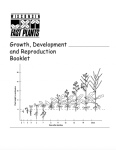Exploring and explaining germination, growth and development
View This Resource
A 32-page booklet, containing complete instructions for activities at each life cycle stage. The booklet also includes important background information about plant physiology and how to grow Fast Plants. A Growth, Development and Reproduction kit is available. You can also conduct all the investigations explained in the booklet using seeds from a packet of Standard Wisconsin Fast Plants seeds (or seeds from Fast Plants you grow yourself) and your own potting mix and growing system. Either way, you'll need to plan for providing adequate light. Learn about all these factors in the How to Grow files on this website.
Alternate Title
Life Cycle
Species
Phenotypic Trait
Media Format
Materials Development Era
Language
Creator
Contributor
Publisher
Rights
This work is licensed under Attribution-NonCommercial-NoDerivatives 4.0 International
Classification
- Educational Resources -- Grade Level: Elementary
- Educational Resources
- Educational Resources -- Grade Level: Secondary
- Educational Resources -- How to grow Fast Plants
- Educational Resources -- Grade Level: Middle School
- Educational Resources -- Grade Level: Elementary -- Current Elementary Resources
- Educational Resources -- Grade Level: Middle School -- Current Middle Level Resources
- Educational Resources -- Grade Level: Secondary -- Current Secondary Resources
- Educational Resources -- Investigations with Fast Plants
NGSS Standard
- NGSS.1.LS1.1 Use materials to design a solution to a human problem by mimicking how plants and/or animals use their external parts to help them survive, grow, and meet their needs.* [Clarification Statement: Examples of human problems that can be solved by mimicking plant or animal solutions could include designing clothing or equipment to protect bicyclists by mimicking turtle shells, acorn shells, and animal scales; stabilizing structures by mimicking animal tails and roots on plants; keeping out intruders by mimicking thorns on branches and animal quills; and, detecting intruders by mimicking eyes and ears.]
- NGSS.3.LS1.1 Develop models to describe that organisms have unique and diverse life cycles but all have in common birth, growth, reproduction, and death. [Clarification Statement: Changes organisms go through during their life form a pattern.] [Assessment Boundary: Assessment of plant life cycles is limited to those of flowering plants. Assessment does not include details of human reproduction.]
- NGSS.3.LS3.1 Analyze and interpret data to provide evidence that plants and animals have traits inherited from parents and that variation of these traits exists in a group of similar organisms. [Clarification Statement: Patterns are the similarities and differences in traits shared between offspring and their parents, or among siblings. Emphasis is on organisms other than humans.] [Assessment Boundary: Assessment does not include genetic mechanisms of inheritance and prediction of traits. Assessment is limited to non-human examples.]
- NGSS.4.LS1.1 Construct an argument that plants and animals have internal and external structures that function to support survival, growth, behavior, and reproduction. [Clarification Statement: Examples of structures could include thorns, stems, roots, colored petals, heart, stomach, lung, brain, and skin.] [Assessment Boundary: Assessment is limited to macroscopic structures within plant and animal systems.]
- NGSS.MS.LS1.4 Use argument based on empirical evidence and scientific reasoning to support an explanation for how characteristic animal behaviors and specialized plant structures affect the probability of successful reproduction of animals and plants respectively. [Clarification Statement: Examples of behaviors that affect the probability of animal reproduction could include nest building to protect young from cold, herding of animals to protect young from predators, and vocalization of animals and colorful plumage to attract mates for breeding. Examples of animal behaviors that affect the probability of plant reproduction could include transferring pollen or seeds, and creating conditions for seed germination and growth. Examples of plant structures could include bright flowers attracting butterflies that transfer pollen, flower nectar and odors that attract insects that transfer pollen, and hard shells on nuts that squirrels bury.]

Comments